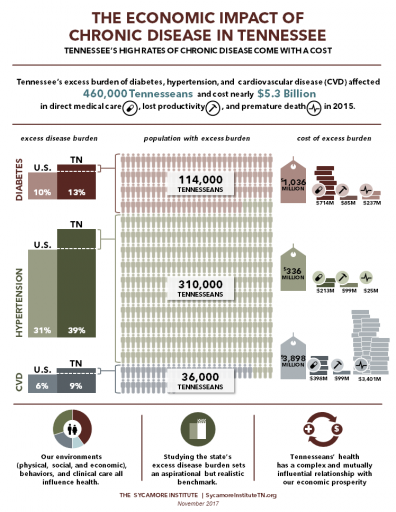If you’re like us, life keeps you busy. We know you WANT to read every last word of our reports and analyses, but some days, you just don’t have time. We get it. That’s why we’re giving you “5 for TN” — five infographics on issues that affect Tennesseans in 2018.
These 1-page summaries cover the basics of a wide range of public policy issues, including:
- Health in Tennessee
- Tennessee’s state budget
- The opioid epidemic in Tennessee
- The economic cost of chronic disease in Tennessee
- TennCare (Tennessee’s Medicaid program)
We’ve published versions of them all before, but several have been updated with new information and the most recent data available in Feb. 2018.
We encourage you to share the images online or print the PDFs and carry them with you. You never know when that one stat will come in handy.
5 Infographics for Tennessee in 2018
Sources & References
Click to Open/Close
Health in Tennessee
Health Indicators and State Rankings
- The Sycamore Institute’s analysis of: U.S. Centers for Disease Control and Prevention (CDC). 2016 Behavioral Risk Factor Surveillance System. Accessed via https://www.cdc.gov/brfss/brfssprevalence/
- U.S. Centers for Disease Control and Prevention (CDC). Underlying Cause of Death 1999-2015. WONDER Online Database. December 2016. http://wonder.cdc.gov/ucd-icd10.html
- Data Resource Center for Child and Adolescent Health. 2016 National Survey of Children’s Health (NSCH). Retrieved 10/26/2017 from http://www.childhealthdata.org
- U.S. Centers for Disease Control and Prevention (CDC). Infant Mortality Rates by State, 2016. January 11, 2018. https://www.cdc.gov/nchs/pressroom/sosmap/infant_mortality_rates/infant_mortality.htm
- U.S. Centers for Disease Control and Prevention (CDC). 2016 Behavioral Risk Factor Surveillance System. Accessed via https://www.cdc.gov/brfss/brfssprevalence/
- United Health Foundation. 2017 America’s Health Rankings. 2017. https://www.americashealthrankings.org/explore/2017-annual-report/measure/Overall/state/TN
Health Insurance Coverage
- The Sycamore Institute’s analysis of: U.S. Census Bureau. 2016 American Community Survey 1-Year Estimates. 2017. Accessed via https://www.census.gov/programs-surveys/acs/data.html
- The Sycamore Institute’s analysis of: U.S. Centers for Medicare and Medicaid Services. 2016 Total Effectuated Enrollment and Financial Assistance by State. Updated August 3, 2017. Accessed via https://data.cms.gov/Marketplace-Qualified-Health-Plan-QHP-/Total-Effectuated-Enrollment-and-Financial-Assista/v9jz-riug
Drivers of Health
- U.S. Census Bureau. 2016 American Community Survey 1-Year Estimates. 2017. Accessed via https://www.census.gov/programs-surveys/acs/data.html
- U.S. Centers for Disease Control and Prevention (CDC). Infant Mortality Rates by State, 2016. Updated January 11, 2018. https://www.cdc.gov/nchs/pressroom/sosmap/infant_mortality_rates/infant_mortality.htm
- U.S. Bureau of Economic Analysis. SA1 Personal Income Summary: Personal Income, Population, Per Capita Personal Income. Updated September 26, 2017. Accessed via https://www.bea.gov/itable/
Adverse Childhood Experiences
- The Sycamore Institute’s analysis of: Tennessee Department of Health. 2016 Behavioral Risk Factor Surveillance System. Provided by the Division of Policy, Planning and Assessment, Office of Health Statistics.
Tennessee State Budget
- The Sycamore Institute’s analysis of: State of Tennessee. Tennessee State Budget Document for FY 2008-2009 – FY 2018-2019. 2008-2018. Accessed via https://www.tn.gov/finance/fa/fa-budget-information.html.
- Tax Foundation. Facts & Figures 2017: How Does Your State Compare? 2017. https://taxfoundation.org/publications/facts-and-figures/
Tennessee’s Opioid Epidemic
The Supply of Prescription Opioids
- Tennessee Department of Health. Controlled Substance Monitoring Database 2017 Report to the 110th Tennessee General Assembly. Health Licensure & Regulation, Controlled Substance Monitoring Database Committee. March 1, 2017. https://www.tn.gov/content/dam/tn/health/healthprofboards/csmd/2017_Comprehensive_CSMD_Annual_Report.pdf
Prescription Opioid Misuse
- U.S. Substance Abuse and Mental Health Services Administration (SAMHSA). Interactive NSDUH State Estimates. http://pdas.samhsa.gov/saes/state
Neonatal Abstinence Syndrome Cases
- Bauer, Audrey M and Li, Yinmei. Neonatal Abstinence Syndrome and Maternal Substance Abuse in Tennessee: 1999-2011. Tennessee Department of Health. [Online] 2013. https://www.tn.gov/content/dam/tn/health/documents/nas/Neonatal_Abstinence_Syndrome_and_Maternal_Substance_Abuse_in_Tennessee_1999-2011.pdf
- Miller, A M and Warren, M D. Neonatal Abstinence Syndrome Surveillance Annual Report 2016. Tennessee Department of Health, Division of Family Health and Wellness. https://www.tn.gov/content/dam/tn/health/documents/nas/NAS_Annual_report_2016_FINAL.pdf
- Tennessee Department of Health. Controlled Substance Monitoring Database 2017 Report to the 110th Tennessee General Assembly. Health Licensure & Regulation, Controlled Substance Monitoring Database Committee. March 1, 2017. https://www.tn.gov/content/dam/tn/health/healthprofboards/csmd/2017_Comprehensive_CSMD_Annual_Report.pdf
Opioid-Related Hospital Use
- Agency for Healthcare Research and Quality (AHRQ). State Inpatient Databases (SID) . Healthcare Cost and Utilization Project (HCUP). [Online] https://www.hcup-us.ahrq.gov/faststats/OpioidUseServlet
- Agency for Healthcare Research and Quality (AHRQ). State Emergency Department Databases (SEDD). Helathcare Cost and Utilization Project (HCUP). [Online] https://www.hcup-us.ahrq.gov/faststats/OpioidUseServlet
Opioid Overdose Deaths
- U.S. Centers for Disease Control and Prevention (CDC). Multiple Cause of Death 1999-2015. National Center for Health Statistics, CDC WONDER Online Database. [Online] http://wonder.cdc.gov/mcd-icd10.html
The Economic Impact of Chronic Disease in Tennessee
- U.S. Centers for Disease Control and Prevention (CDC). 2015 Behavioral Risk Factor Surveillance System. Accessed via https://www.cdc.gov/brfss/brfssprevalence/
- For the full methodology, see: The Sycamore Institute. The Economic Impact of Chronic Disease in Tennessee. November 15, 2017. https://www.sycamoretn.org/cost-chronic-disease-tennessee/
Tenncare 101
Funding/Budget Data
- The Sycamore Institute’s analysis of: State of Tennessee. Tennessee State Budget Documents for FY 1996-1997 – FY 2018-2019. 1996-2018. Accessed via https://www.tn.gov/finance/fa/fa-budget-information.html.
Enrollment Information
- TennCare. TennCare Historical Expenditure and Enrollment Data. https://www.tn.gov/content/dam/tn/tenncare/documents/historicalchart.pdf
- TennCare. TennCare Enrollment Report for June 2017. 2017. https://www.tn.gov/content/dam/tn/tenncare/documents2/fte_201706.pdf
Expansion
- Buettgens, Matthew and Kenney, Genevieve. What if More States Expanded Medicaid in 2017? Changes in Eligiblity, Enrollment, and the Uninsured. Robert Wood Johnson Foundation and Urban Institute. [Online] July 2016. https://www.urban.org/sites/default/files/publication/82786/2000866-What-if-More-States-Expanded-Medicaid-in-2017-Changes-in-Eligibility-Enrollment-and-the-Uninsured.pdf
- Dorn, Stan and Buettgens, Matthew. The Cost of Not Expanding Medicaid: An Updated Analysis. Robert Wood Johnson Foundation and Urban Institute. [Online] April 2017. https://www.urban.org/sites/default/files/publication/89986/2001246_the_cost_of_not_expanding_medicaid_updated_analysis.pdf
- Garfield, Rachel and Damico, Anthony. The Coverage Gap: Uninsured Poor Adults in States that Do Not Expand Medicaid. The Kaiser Family Foundation. [Online] November 1, 2017. https://www.kff.org/uninsured/issue-brief/the-coverage-gap-uninsured-poor-adults-in-states-that-do-not-expand-medicaid/






